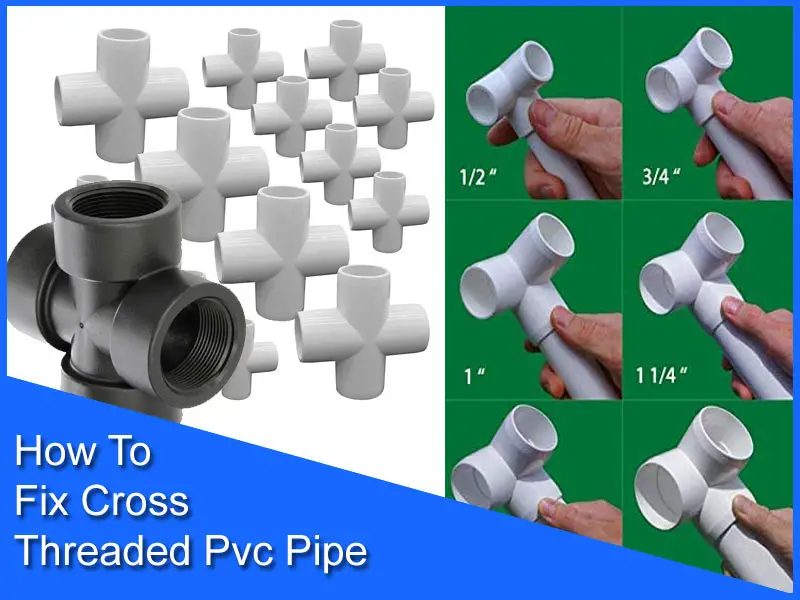Cross-threaded PVC connections are often the weakest components of an irrigation system. If installed incorrectly, they can easily lead to leaks or complete failure of the connection due to improper application of sealant products and more commonly, over-tightening.
How To Fix Cross Threaded Pvc Pipe
If you are going through a problem related to your PVC fitting you have to what kind of reasons are behind it and how to fix cross-threaded PVC pipe on that matter of the case.
If you are going to do this job on your own and need some possible solutions then don’t worry here we are going to explain to you all that you need to know for your possible problem-solving.

Causes Of Cross-threaded Pvc Pipe Malfunctions And How To Fix It?
Male and female pipe threads are tapered. Male threads get wider with each thread while female threads get narrower. This allows them to wedge together to form a better seal. However, the sealant is also required to fill in voids between the root and crest of the threads that otherwise would be an opportunity for fluids to escape.
As we’ve mentioned, over-tightening is commonly the reason for the failure of threaded PVC connections. If the male end of a threaded fitting is forced down so far into the female side it creates stress that the plastic can not withstand.
Using too much-threaded tape will increase this stress and eventually cause the fitting to crack or split. Manufacturers of PVC fittings and other experts in the field seem to agree that the best method for making threaded connections is to use pipe thread sealant vs. PTFE thread tape, commonly referred to as Teflon tape.
It’s said that the lubricating characteristic of thread tape is intended to prevent galling on metal fittings. Using it on PVC can give the installer the false sensation of the fitting not being tight enough, so they end up over-tightening the connection.
On the other hand, the PVC pipe and fittings association recommends using PTFE thread tape. They state that there are many types of oil-based thread sealants, designed for metal, that are chemically incompatible with PVC. Using the wrong type of sealant can also damage spray heads and valves.
This is why you will often see úse no pipe dope’ printed on some of these products. If you choose to use a thread sealant, it should be non-hardening and approved for use in a PVC. whether you prefer to use PTFE tape or thread sealant, it’s important to know how much to use, how to apply it, and how far down you should tighten the fitting.
If you decide to go with threaded tape, use white PTFE tape that’s at least 3-mil in thickness. The tape width you’ll want to use will depend on the size of the fitting you are working with. The tape should be wrapped in the same direction as the thread spiral. This prevents the tape from bouncing up or unwrapping as you make the connection.
Make sure the threads are clean, hold the fitting in your left hand and align the edge of the tape over the threads so that it’s parallel to the end of the fitting. You want to cover the first thread but don’t allow the tape to extend past the edge of the fitting.
Now press down on the end of the tape with your thumb to hold it in place and begin wrapping in a clockwise direction. As you wrap, pull with enough force to stretch the tape slightly, forcing it down into the threads without slicing thru the tape. Each successive wrap should cover at least ½ of the width of the wrap below it.
Once you’ve made no more than 2 to 3 rotations, press down on the tape where you want o make the break and pull. Finally, smooth the loose end of the tape down into the threads. When you make the connection, it should be finger-tight plus a maximum of 2 full rotations. Tightening more than 2 rotations will apply unwanted stress to the female side of the connection.
It’s also important not to back out the threads after you’ve made the connection. Using serrated gripping tools is not recommended. Use a strap wrench or crescent wrench depending on the fighting you are working with.
If you prefer to use a thread sealant instead of tape, apply the paste in an even coat to the male threads only, mostly filling in the crevices. Be careful not to apply too much or the excess can squeeze out and possibly clog valves, spray heads, or emitters. As with the thread tape, finger-tighten the fitting as you make the connection then complete no more than two additional full rotations.
One last thing to note: if you are connecting nipples or male adapters to an irrigation valve, refer to the valve manufacturer’s installation instructions. Most only require half to one full turn past finger tight when tightening the connections.
You might also like
- How To Repair Damaged Pipe Threads
- How To Cut Copper Pipe In Tight Space
- 5 Ways How To Remove Wooden Dowels
- How To Use Scalp Massager
- How To Measure Whipped Cream
- How To Get Hard Candy Out Of The Pan at Home
Final Verdict
Regardless of your personal sealant preference, hopefully, this information will help you make better leak-free threaded connections in the future. Both PTFE thread tape and thread sealant products can be found at your local store. So we hope now you’ve found your solution of how to fix cross-threaded PVC pipe and the reasons behind the problems.
